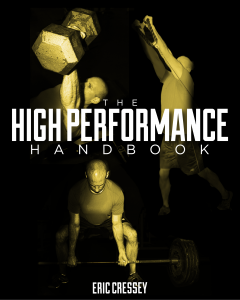Weight Training Programs: You Can’t Just Keep Adding
Can I just add some sets and reps of direct arm work?
How about cardio? Would a few 30 minutes interval training sessions work?
What if I did extra rotator cuff stuff every day? Just a little tubing, you know?
I’m going to add two extra days of calves, abs, and forearms. It shouldn’t be a problem, right?
These are just a few of the common questions I receive from people for whom I write strength training programs (plus all the other components of a comprehensive program). And, it’s these kind of questions that make me appreciate just how challenging it is to teach someone how to effectively write strength and conditioning programs – and why everyone gets all flustered when they first start writing training plans.

Very simply, most people don’t understand the concept of competing demands. Everybody wants to add something to their weight training program – but not everyone is willing to take something away in order to do so.
How many elite powerlifters or Olympic lifters do you know who regularly do interval training as part of their quest to get strong?
How many elite triathletes do you know who just want to add a few sets of biceps curls along the road to improving endurance performance?
The answer is, of course, none. And, it’s because – whether they appreciated it or not – these high-level athletes were effectively managing competing demands.
In some cases, different fitness qualities compete with one another; an example would be extensive aerobic training while trying to increase strength. You can’t get strong quickly if you’re doing hours of cardio each week. Somewhat similarly, in an overhead throwing population, it’s challenging to regain shoulder internal rotation and flexion range of motion (ROM) and pec minor length when an athlete is throwing – so you have to do your best to get the ROM during down-time in their training year.
In other cases, you may have multiple qualities that contribute to an overall training effect, but you can’t prioritize all of them at once. For example, my professional baseball clients need a host of different qualities to be successful, but the body has limited recovery capacity, so their training programs have to target their most readily apparent weaknesses – and do so at the right time of year. We cut back on the medicine ball and upper body strength exercises and volume when their throwing volume increases.
And, we can’t do as much lower body strength exercises when guys are doing more sprinting and change-of-direction work. Stress is stress, so you have to apply it judiciously.
Taking this into consideration, I think that one of the best drills for someone looking to get better at writing programs is to take a full-on comprehensive weight training program with supplemental conditioning/movement training where someone is training 6x/week – and then cut it back to 3x/week. Assume that there is a whole lot of of “other” stress in this athlete/client’s life – whether it’s work, illness, family issues, or just being an in-season athlete – and figure out how to scale a program back in order to make it productive and safe for that individual.
Lots of factors have to be taken into account: the volume and intensity that individual can handle, how long each session can last, and what specific factors one needs to address most. A good example to check out would be the differences between the 4x/week, 3x/week, and 2x/week weight training programs (and accompanying optional supplemental sessions) in The High Performance Handbook.
There are loads of factors you have to take into account when you write a comprehensive training plan – from the weight training program, to soft tissue work, to mobility work, to movement training, to energy systems training. The most important consideration, though, is how they all fit together synergistically to make the program as a whole effective.
So, try the challenge I listed above and see how you do; I think you’ll find that it’s a lot harder to subtract than it is to add to your weight training programs.



